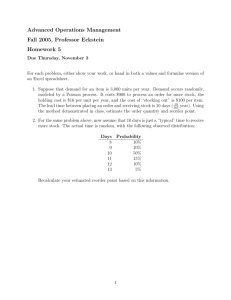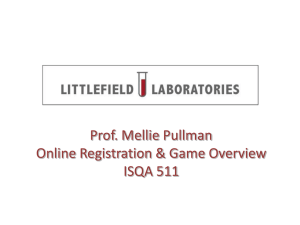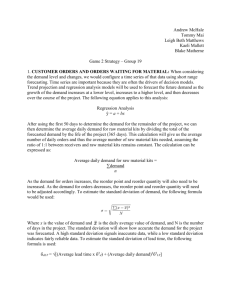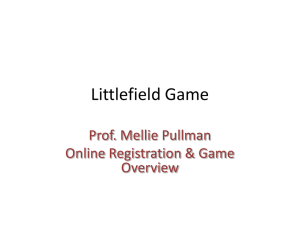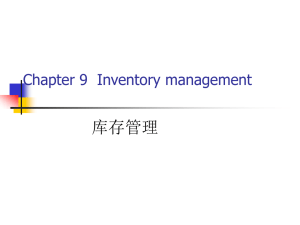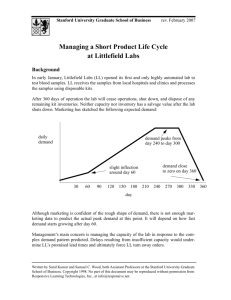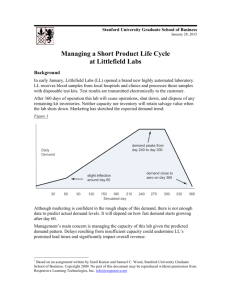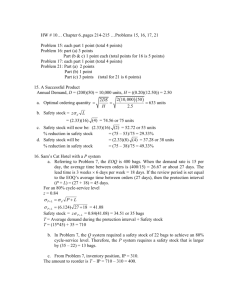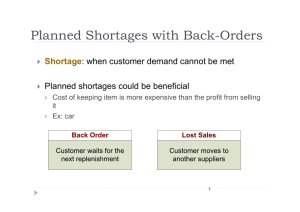Littlefield Technologies Game 2 Strategy – Group 28 1. CUSTOMER
advertisement
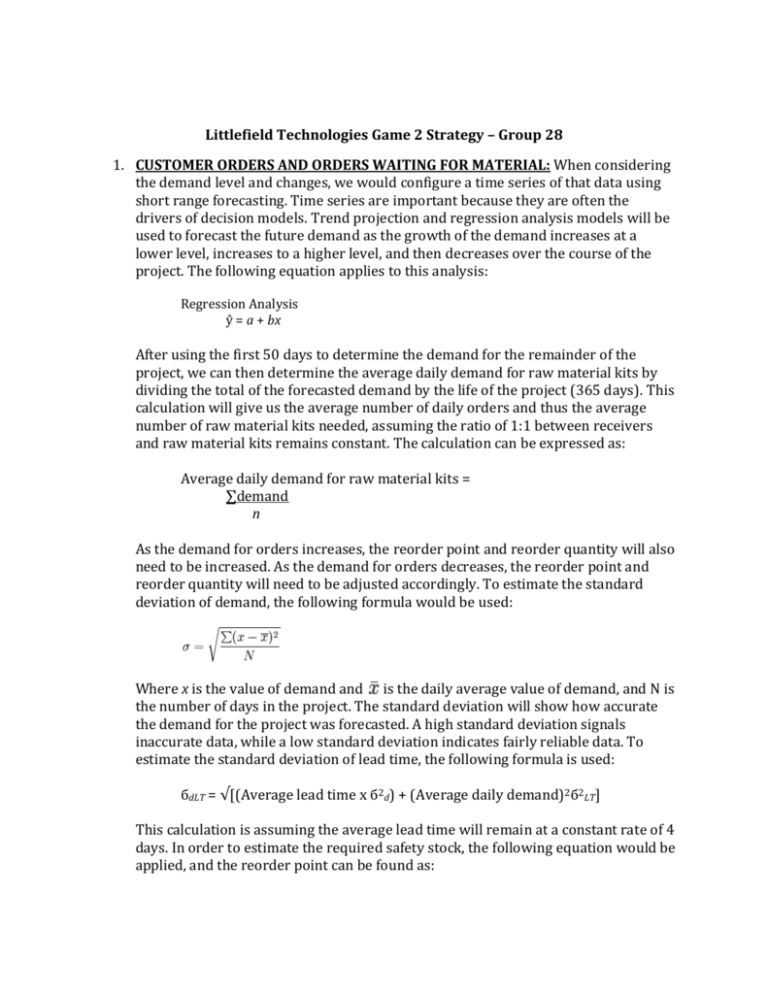
Littlefield Technologies Game 2 Strategy – Group 28 1. CUSTOMER ORDERS AND ORDERS WAITING FOR MATERIAL: When considering the demand level and changes, we would configure a time series of that data using short range forecasting. Time series are important because they are often the drivers of decision models. Trend projection and regression analysis models will be used to forecast the future demand as the growth of the demand increases at a lower level, increases to a higher level, and then decreases over the course of the project. The following equation applies to this analysis: Regression Analysis ŷ = a + bx After using the first 50 days to determine the demand for the remainder of the project, we can then determine the average daily demand for raw material kits by dividing the total of the forecasted demand by the life of the project (365 days). This calculation will give us the average number of daily orders and thus the average number of raw material kits needed, assuming the ratio of 1:1 between receivers and raw material kits remains constant. The calculation can be expressed as: Average daily demand for raw material kits = ∑demand n As the demand for orders increases, the reorder point and reorder quantity will also need to be increased. As the demand for orders decreases, the reorder point and reorder quantity will need to be adjusted accordingly. To estimate the standard deviation of demand, the following formula would be used: Where x is the value of demand and is the daily average value of demand, and N is the number of days in the project. The standard deviation will show how accurate the demand for the project was forecasted. A high standard deviation signals inaccurate data, while a low standard deviation indicates fairly reliable data. To estimate the standard deviation of lead time, the following formula is used: бdLT = √[(Average lead time x б2d) + (Average daily demand)2б2LT] This calculation is assuming the average lead time will remain at a constant rate of 4 days. In order to estimate the required safety stock, the following equation would be applied, and the reorder point can be found as: Safety Stock = ΖбdLT ROP = Expected demand during lead time + Safety Stock A higher demand and lead time would require a higher safety stock, leading to a higher reorder point, in order to conserve reliability and resources. This situation would also be true vice versa if the demand was low. At the beginning of the game, the reorder point will automatically be set to 2000 kits when the demand is low, and will be increased as demand increases. We will calculate safety stock using varying service levels (90%, 91%, 92%, etc.) in order to predict and illustrate multiple reorder point outcomes. 2. INVENTORY ORDERING AND HOLDING COST: Ordering costs include costs of supplies, forms, order processing, purchasing, and clerical support. As the orders are being manufactured, setup costs are produced. There are also holding costs to consider which include the costs associated with carrying the inventory over time. For the Littlefield Technologies situation, the total of these costs would also include production: TC = (D/Q)S + (Q/2)H + PD Total cost can be used as a factor in determining the reorder quantity. The reorder quantity must be high enough to satisfy the demand requirements, but low enough to efficiently conserve the cash balance. We can use the EOQ Model to minimize the total of ordering and holding costs, found as: EOQ = Q = √(2DS/H) This would give us the optimal order size. As the quantity ordered increases, the total number of orders place per year will decrease. Thus, as the quantity ordered increases, the annual setup or ordering cost will decrease. But as the order quantity increases, the holding costs will increase due to the larger average inventories that are maintained. If the demand doubles during the year, and all else remains constant the reorder quantity should be increased by 41%. 3. RAW MATERIALS IN BUFFER: Raw material buffer are goods held at the end of a process to protect the company in the event of an abrupt increase in demand that exceeds a short-term production capacity. Safety stock is an extra stock of inventory held to allow for uneven demand. The difference between the two is that buffer stock protects your consumers in the event of an abrupt demand change while safety stock protects the company itself from incapacity in processes and supply chains. The buffer must be high enough to cover the company’s extra inventory requirements in the event of an abrupt change in demand, while also being low enough to utilize monetary resources effectively. 4. OUTSTANDING ORDERS FOR MATERIAL: To keep the company from using their buffer stock and to keep the number of raw kits outstanding low in the process, the reorder point (ROP) must be at a value that re-orders inventory at the right period of time while also keeping the cost of inventory at a lower level. We also have to take into consideration the lead time of 4 days. If the ROP is not set at the correct value, the lead time will delay the production of raw kits and increase the number of orders outstanding. 5. PROJECT MANAGEMENT: We can apply multiple project management concepts to planning the project, scheduling the project, and controlling the project. First, the project was planned and scheduled by setting a goal of completion. Our goal was to have the strategy and Excel document completed by Tuesday, November 15th. Using a work break-down structure, one team member worked on the description of the game strategy while the other group members divided the work of the Excel spreadsheet. We communicated these ideas by first collaborating with all group members through email, deciding where to meet up, and working on the project together in a classroom setting. This is a prime example of a positive group experience, as our actions within the group are well communicated and each group member’s ideas are considered thoughtfully. Compared to Phase I of the game strategy, we quickly knew how to break-up the project into a basic and common understanding. To improve this group experience, more time would need to be allotted to completing the project before the expected due date, as to reduce stress and confusion.
